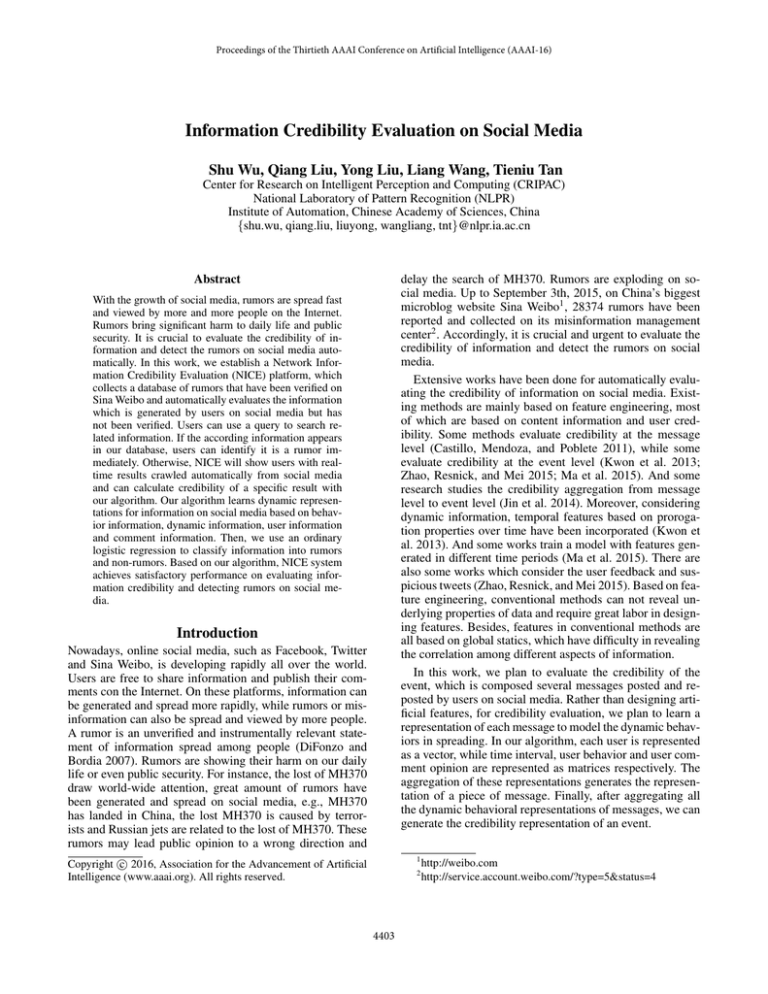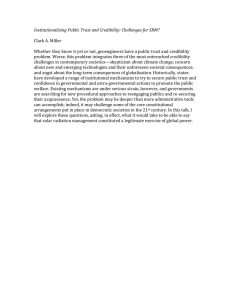
Proceedings of the Thirtieth AAAI Conference on Artificial Intelligence (AAAI-16)
Information Credibility Evaluation on Social Media
Shu Wu, Qiang Liu, Yong Liu, Liang Wang, Tieniu Tan
Center for Research on Intelligent Perception and Computing (CRIPAC)
National Laboratory of Pattern Recognition (NLPR)
Institute of Automation, Chinese Academy of Sciences, China
{shu.wu, qiang.liu, liuyong, wangliang, tnt}@nlpr.ia.ac.cn
delay the search of MH370. Rumors are exploding on social media. Up to September 3th, 2015, on China’s biggest
microblog website Sina Weibo1 , 28374 rumors have been
reported and collected on its misinformation management
center2 . Accordingly, it is crucial and urgent to evaluate the
credibility of information and detect the rumors on social
media.
Extensive works have been done for automatically evaluating the credibility of information on social media. Existing methods are mainly based on feature engineering, most
of which are based on content information and user credibility. Some methods evaluate credibility at the message
level (Castillo, Mendoza, and Poblete 2011), while some
evaluate credibility at the event level (Kwon et al. 2013;
Zhao, Resnick, and Mei 2015; Ma et al. 2015). And some
research studies the credibility aggregation from message
level to event level (Jin et al. 2014). Moreover, considering
dynamic information, temporal features based on prorogation properties over time have been incorporated (Kwon et
al. 2013). And some works train a model with features generated in different time periods (Ma et al. 2015). There are
also some works which consider the user feedback and suspicious tweets (Zhao, Resnick, and Mei 2015). Based on feature engineering, conventional methods can not reveal underlying properties of data and require great labor in designing features. Besides, features in conventional methods are
all based on global statics, which have difficulty in revealing
the correlation among different aspects of information.
In this work, we plan to evaluate the credibility of the
event, which is composed several messages posted and reposted by users on social media. Rather than designing artificial features, for credibility evaluation, we plan to learn a
representation of each message to model the dynamic behaviors in spreading. In our algorithm, each user is represented
as a vector, while time interval, user behavior and user comment opinion are represented as matrices respectively. The
aggregation of these representations generates the representation of a piece of message. Finally, after aggregating all
the dynamic behavioral representations of messages, we can
generate the credibility representation of an event.
Abstract
With the growth of social media, rumors are spread fast
and viewed by more and more people on the Internet.
Rumors bring significant harm to daily life and public
security. It is crucial to evaluate the credibility of information and detect the rumors on social media automatically. In this work, we establish a Network Information Credibility Evaluation (NICE) platform, which
collects a database of rumors that have been verified on
Sina Weibo and automatically evaluates the information
which is generated by users on social media but has
not been verified. Users can use a query to search related information. If the according information appears
in our database, users can identify it is a rumor immediately. Otherwise, NICE will show users with realtime results crawled automatically from social media
and can calculate credibility of a specific result with
our algorithm. Our algorithm learns dynamic representations for information on social media based on behavior information, dynamic information, user information
and comment information. Then, we use an ordinary
logistic regression to classify information into rumors
and non-rumors. Based on our algorithm, NICE system
achieves satisfactory performance on evaluating information credibility and detecting rumors on social media.
Introduction
Nowadays, online social media, such as Facebook, Twitter
and Sina Weibo, is developing rapidly all over the world.
Users are free to share information and publish their comments con the Internet. On these platforms, information can
be generated and spread more rapidly, while rumors or misinformation can also be spread and viewed by more people.
A rumor is an unverified and instrumentally relevant statement of information spread among people (DiFonzo and
Bordia 2007). Rumors are showing their harm on our daily
life or even public security. For instance, the lost of MH370
draw world-wide attention, great amount of rumors have
been generated and spread on social media, e.g., MH370
has landed in China, the lost MH370 is caused by terrorists and Russian jets are related to the lost of MH370. These
rumors may lead public opinion to a wrong direction and
1
c 2016, Association for the Advancement of Artificial
Copyright Intelligence (www.aaai.org). All rights reserved.
2
4403
http://weibo.com
http://service.account.weibo.com/?type=5&status=4
User
information
Online
search
Query
Select
Result list
Search
Event seed
Event
microblogs
Offline
search
Content
information
Time
information
Comment
information
Train
Historical
data
NICE
model
Predict
Labeled
rumors
Predicted
credibility
Figure 1: Overview of NICE system.
Algorithm
Weibo and used similar process of crawling rumors to collect corresponding information. Finally, this database contains the verified rumors and non-rumors, which are used to
train our model.
Figure 1 illustrates the flow chart of the NICE system. The
user can input a query to retrieval the related information using the system. If a user’s query matching the rumor in the
database, users can identify the rumor immediately. Otherwise, NICE will crawl real-time information from social media, and user can select an event to evaluate the information
credibility based on our model. Based on the selected microblog, the system will crawl the related microblogs from
Weibo, and collect related information including content information, time information, comment information and corresponding user profile. Based on these information and the
trained model, NICE can evaluate the credibility of the related information and provide a predicted score of the event.
In this work, our task is to predict the credibility of an event,
which contains several messages (posting or reposting). For
an event ei containing nei messages (denoted as a set M ei ),
we can learn event representation as:
1
(Tet i + Cej i + Bej i )uej i ,
(1)
r ei =
nei ei e
mj ∈M
i
where mej i is a message of the event ei , uej i is latent vector
of the corresponding user posted or reposted the message
mej i , Bej i is operating matrix of his or her behavior (posting
or reposting), Cej i means the operating matrix of comment
opinion (whether the message is suspicious or nor), latent
matrix Tej i denotes operation of the time interval since the
beginning of the event.
Then, after generating the credibility representations of
events, we apply Logistic Regression (LR) for learning of
the model, where the prediction whether an event ei is a rumor can be calculated as:
y ei =
1
,
e
1 + e−wT r i
Acknowledgments
This work is jointly supported by National Basic Research
Program of China (2012CB316300), and National Natural
Science Foundation of China (61403390, U1435221).
(2)
References
where w is a latent vector denoting the weights of regression. Based on this model, using the related information of
an event, we can evaluate the credibility of the event.
Castillo, C.; Mendoza, M.; and Poblete, B. 2011. Information
credibility on twitter. In WWW, 675–684.
DiFonzo, N., and Bordia, P. 2007. Rumor, gossip, and urban legend. Diogenes 54(1):19–35.
Jin, Z.; Cao, J.; Jiang, Y.-G.; and Zhang, Y. 2014. News credibility
evaluation on microblog with a hierarchical propagation model. In
ICDM, 230–239.
Kwon, S.; Cha, M.; Jung, K.; Chen, W.; and Wang, Y. 2013.
Prominent features of rumor propagation in online social media.
In ICDM, 1103–1108.
Ma, J.; Srivastava, M.; Toniolo, A.; and Norman, T. J. 2015. Detect rumors using time series of social context information on microblogging websites. In CIKM.
Zhao, Z.; Resnick, P.; and Mei, Q. 2015. Enquiring minds: Early
detection of rumors in social media from enquiry posts. In WWW,
1395–1405.
System
The NCIE system is constructed based on our algorithm
and historical dataset collected from Sina Weibo. In order
to train the model, we first construct a database containing
rumors and non-rumors from Sina Weibo. To crawl rumors,
we first collected some rumor seeds from misinformation
management center of Sina Weibo, then extracted key words
from the rumor seeds and retrieved microblogs based on
these key words. We crawled all the matching microblogs,
and for each microblog, we collected its reposts, comments,
dynamic information and the corresponding user’s profile.
To crawl non-rumors, we collected some hot topics on Sina
4404







